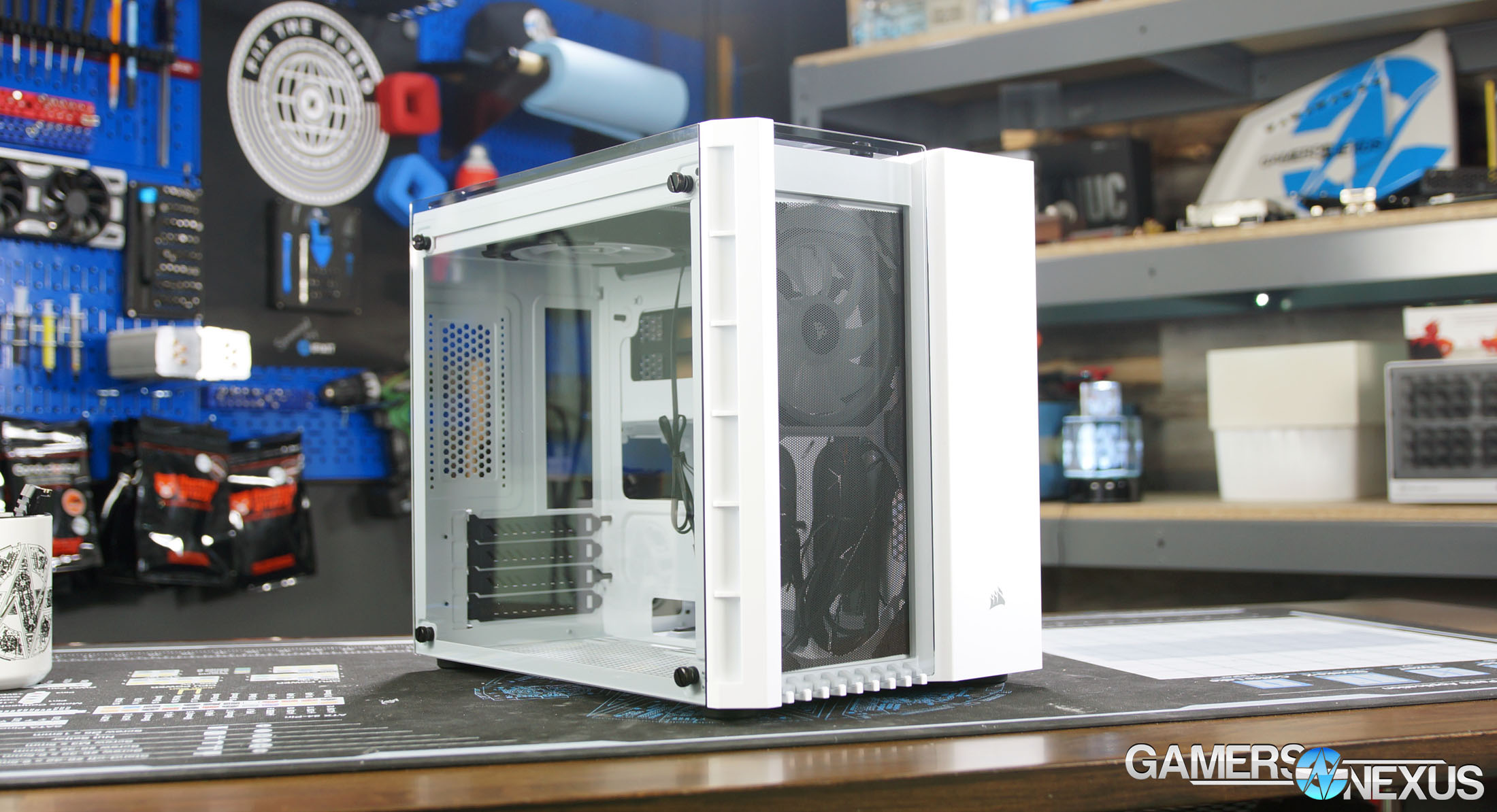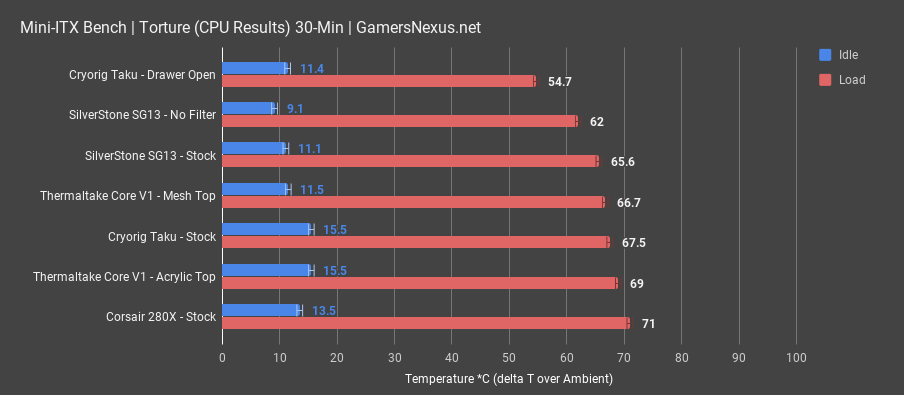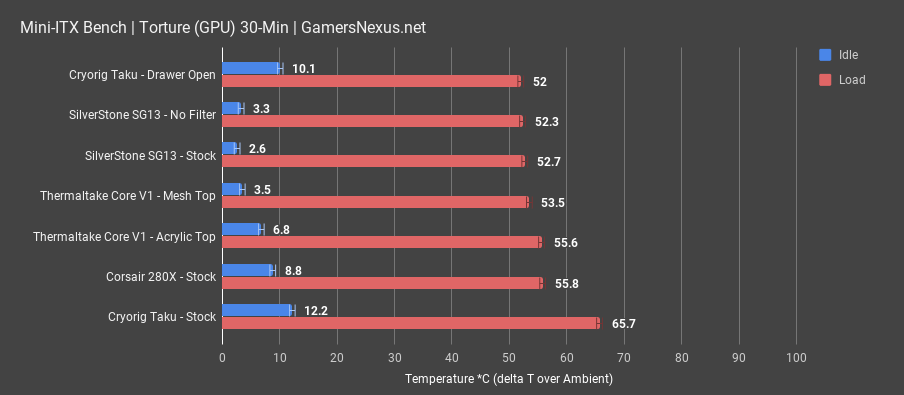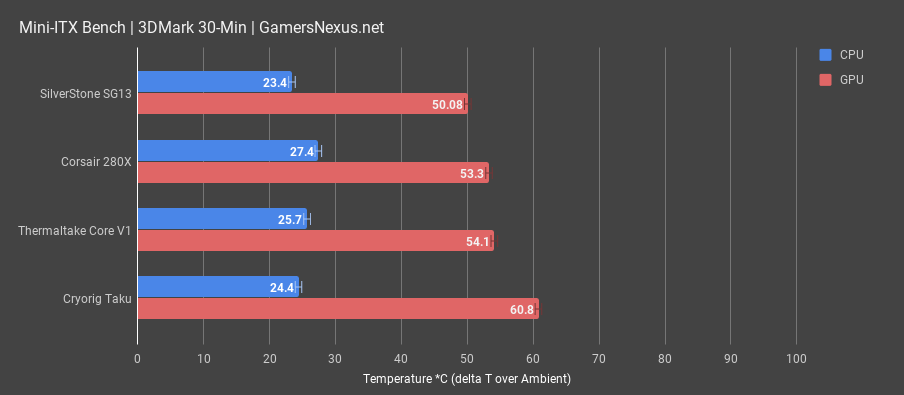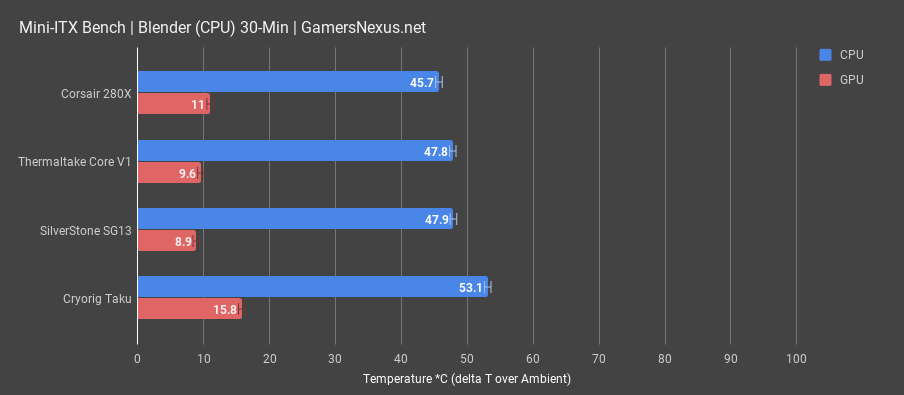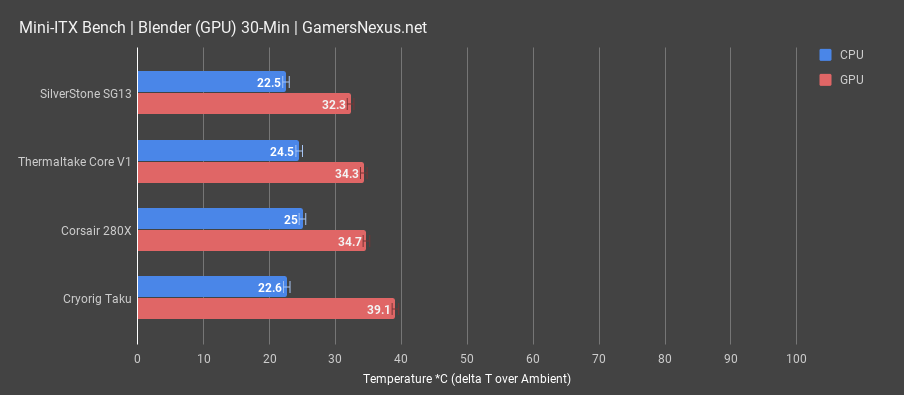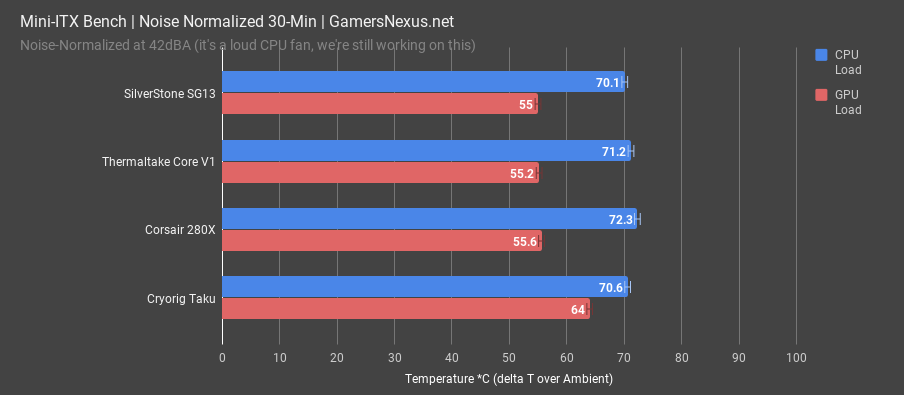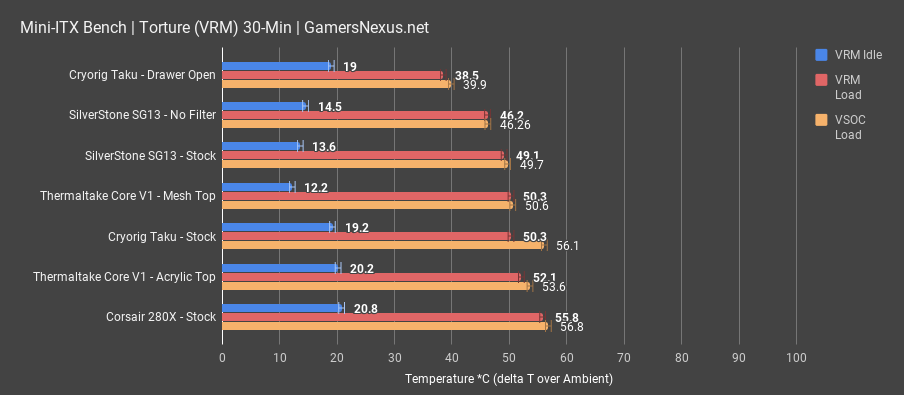The review embargo on Corsair’s new Crystal 280X micro-ATX case lifted during Computex, possibly the busiest week of the year--but since we’ve just started testing small form factor cases, we chose to push back the review another week or two.
The 280X is fairly large to call itself small form factor, and that can be an unfair advantage when comparing performance against truly small mini-ITX cases like the SG13. One justification is that (unlike the Cryorig Taku), the 280X uses its extra room to supports full-size components except for the motherboard, which must be either micro ATX or mini ITX.
Corsair 280X Case Specs
280X | 280X RGB | |
MSRP | $109.99 | $159.99 |
Exp. Slots | 4 | 4 |
Side Panel | Tempered Glass | Tempered Glass |
Available Colors | Black, White | Black, White |
Storage | 2 x 3.5”, 3 x 2.5” | 2 x 3.5”, 3 x 2.5” |
Included Fans | 2 x 120mm | 2 x 120mm LL RGB |
Total Fan Support | 6 x 120mm | 6 x 120mm |
Lighting Control | None | 1 x Lighting Node PRO |
Front Rad | 240mm | 240mm |
Top Rad | 240 / 280mm | 240 / 280mm |
Bottom | 120 / 140mm fans only (MITX only) | 120 / 140mm fans only (MITX only) |
Max GPU Length | 300mm | 300mm |
Max Cooler Height | 150mm | 150mm |
Max PSU Length | 180mm | 180mm |
Front I/O | USB 3.1 Type-A x 2 | USB 3.1 Type-A x 2 |
Dust Filters | Front + Top + Bottom + PSU | Front + Top + Bottom + PSU |
The Build - Corsair Crystal 280X Build Quality
The 280X is a bit similar to the O11 Dynamic in appearance and layout. The larger section of the case to on the left houses the motherboard and GPU, and the smaller chamber to the right holds the PSU, drives, and cables. Drive support is as good as many mid-towers, with an HDD cage that can hold two 3.5” drives and another cage that can hold three 2.5” drives. Both of these cages are removable and held in by a thumbscrew, but there was plenty of room even with the cages installed. The PSU and HDD cage are stacked on top of each other and are accessible from the rear of the case, which makes adding and removing hard drives extremely easy.
Repeatedly opening the case during testing got old very quickly. The top and side glass panels are held on with four thumbscrews apiece, but we’ve seen better designs from Corsair before and we’d like to see manufacturers move towards more convenient ways to fasten glass panels. The rubber washers that pad the glass are held captive in the panel (which is nice) and they hold the panels away from the case to allow airflow, much like the View 71. The front glass panel isn’t intended to be removable and is unfortunately held captive by plastic pegs and sticky tape--in order to remove the front filter, either the front fan or the whole front panel assembly must be removed. Removing the glass would be much quicker, and we suspect that it may have originally been intended to be removable.
Cable management is excellent since there’s so much room behind the motherboard. There are cable tie points scattered around, but there was so much room for loose cables that we didn’t need to use any of them. Cutouts are huge, well-placed, and more plentiful than they are in most full-sized cases, but micro ATX boards will cover two of the largest cutouts towards the front of the case.
There are two 120/140mm mounts each on the top, front, and bottom of the case (usable only with mini-ITX boards), and one more on the non-glass side. The side mount isn’t particularly useful, but it’s better to have too many mounting locations than too few. Neither of the bottom mounts are filled in the stock configuration, but a bottom-intake configuration could be a good fit if the legs were a little longer and there was more clearance underneath. As it is, airflow is just as restricted from the bottom as it is from the front.
The RGB version of the case comes with two ARGB fans and a “Corsair Lighting Node PRO” controller, but software wasn’t ready at the time of review and we never bothered enabling the LEDs, so we’ll just pretend we got the non-RGB version.
Mini-ITX Case Testing Methodology
Our hardware was chosen for maximum compatibility with a wide range of mini-ITX cases: we’re using a low-profile cooler, small PSU, short GPU, and an APU for any cases where a discrete GPU doesn’t fit at all. The 2400G is configured to a fixed 3.7GHz in order to ensure consistent frequency performance under benchmarks.
Mini-ITX reviews are the least scientific of any case reviews. They’re difficult to do, and it’s a challenge to look at huge lists of thermal benchmarks to determine an obvious “best.” With ITX cases, the subjective enters play to an extreme that we can’t just “review” -- a lot of that will be up to viewers. For examples of this, Case A might be half the size of Case B (in volume), and while both are still significantly smaller than even Micro-ATX boxes, Case B might be “too big” for some users. ITX cases range between true-to-form shuttle boxes and cases that are functionally mid-towers, with some oddballs in the set-top box category (read: no dGPU support at all). While something like the SG13 (11.5 liters) might seem the incarnation of a perfect ITX box, it does suffer from reduced ease-of-installation and cable management -- that’s the nature of such a small box; then again, another user might see the Thermaltake Core V1 -- still a verifiably small case -- and think that 22.7 liters is simply too large.
Component compatibility is also a large question mark with ITX case reviews: When considering GPU lengths, for instance, many modern ITX cases can fit full-length reference cards, but that doesn’t mean they should be outfitted with those cards. Thermal considerations would sometimes dictate that a half-length/mini card is a better choice. Other boxes simply won’t support full-length cards, and thus would be incompatible with a test bench that standardizes full-length GPUs.
Then you have instances of cooling support: Unlike ATX cases, where we’re 90% guaranteed that all cases will support at least a 150mm tower or at least a 240mm CLC, ITX cases are all over the place. Some demand a less-than 50mm-tall heatsink, others can support mini-towers up to 92mm, some have 0 CLC support, some specialize in CLC support. In order to standardize for the least common denominator and support the most cases, we opted for a 50mm cooler height; unfortunately, cases that can legitimately support larger coolers will appear marginally ‘gimped’ in these tests, comparatively, as we’re restricting them to a smaller standard.
The point is, despite all efforts to control for the test environment, sometimes science isn’t the only proper approach to a benchmark. In these instances of ITX reviews, we’ll provide standardized thermal tests, then also ask that you consider more subjective factors. We’ll lay those out in the text sections in each review.
Here’s the parts listing:
Mini-ITX Case Test Bench, Sponsored by Gigabyte & Enermax
| Part Name | Provided by | |
| CPU | AMD R5 2400G @ 3.7GHz, 1.225V @ LLC5 | GamersNexus |
| RAM | GSkill Trident Z 3200MHz CL14 | GSkill |
| Motherboard | Gigabyte AB350N ITX | Gigabyte |
| PSU | Enermax Revolution SFX 650W | Enermax |
| GPU | Gigabyte GTX 1070 Mini | Gigabyte |
| Cooler | Cryorig C7 | Cryorig |
| SSD | Samsung 850 Evo | GamersNexus |
Noise testing is still being refined, as we’re somewhat bound by the CPU cooler right now (more than the cases). Anything involving noise -- which will primarily be focused on in future reviews, not this one -- is measured at the usual 20” distance range for our testing. The noise floor is ~26dB.
Thermal testing is where it gets more detailed: We’ve added frequency over time charts for GPU core clocks, useful for determining the impact of poor cooling, and we’ve also added VRM thermal measurements by placing thermocouples on the MOSFETs. This will mostly help to identify weak spots in case cooling capabilities. As always, all tests are conducted for a minimum of 30 minutes.
Thermals & Noise
For additional testing, we limited ourselves to a noise normalized test (42.8dB to match the other ITX cases we’ve reviewed) and one test with the top filter removed. The top filter is completely unnecessary in the stock top-exhaust configuration since the glass panel will prevent any dust from passively settling into the case, and we recommend removing it for anything but a top-intake configuration. For the noise normalized test we generally turn the CPU fan down to 80% and then adjust the case fans down, but the 280X was quiet enough that we were able to run the case fans at 100% and the CPU fan at 90%.
CPU Torture
Average CPU temperature was 71 degrees Celsius over ambient during the torture test, which rose only slightly to 72.3C dT during the later-discussed noise normalized test. Again, we only had to slightly lower the CPU fan speed to reach the desired noise threshold, so it makes sense for the results to be almost exactly the same as stock. Removing the top filter allowed the exhaust fan to push a noticeably larger amount of air, and lowered average CPU temperature to 67.2 above ambient.
CPU Torture (Comparative)
Looking at comparative thermals, 71 degrees is highest CPU delta on our chart, but we’ve only tested three small form factor cases previously. The stock intake fan is pointed directly towards the CPU cooler, but hot GPU exhaust must travel upwards directly past the CPU in order to escape. The top exhaust fan drags GPU exhaust through the cooler, and because we’re using a standardized downdraft cooler intended for smaller ITX cases, the result is a significantly warmer CPU result than in cases with less aggressive exhaust. The glass front panel also doesn’t do the intake fan any favors. Removing the top filter (which we recommend) puts CPU temperatures on par with the Cryorig Taku and a couple degrees below the stock Thermaltake V1.
GPU Torture
Moving on to torture GPU temperature, average GPU dT under the torture workload was 55.8C in the stock configuration and wasn’t significantly affected by the adjustment of the CPU fan for the noise normalized test. Despite the distance between the GPU and the top of the case, removing the top filter allowed the single exhaust fan to work more effectively and lowered GPU dT several degrees to 51.6C.
GPU Torture (Comparative)
Comparatively, 55.8 dT is nowhere near as bad as GPU temperatures were in the Taku, but 51.6dT with the top filter removed is the lowest GPU dT among the four cases now on our chart. The size of the case means that the GPU has plenty of room to breathe, and the conventional airflow pattern means that exhaust freely flows both out the back of the case and upwards towards the top panel. An additional intake fan under the stock one at the front of the case could help even more, but an intake fan directly under the GPU would be better. We do strongly suggest removing the top filter, as it’s unnecessary when considering the exhaust nature of the stock fan.
3DMark
3DMark as a gaming stand-in presents the 280X at 53.3C GPU dT, and puts it close to the Thermaltake V1, better than the Cryorig Taku and worse than the Silverstone SG13. It’s possible that with the top filter removed the 280X could beat them all. CPU dT was 27.4C, a few degrees higher than the other cases, despite the CPU not really being loaded during this test--more evidence of GPU exhaust heating the CPU cooler.
Blender
Average CPU dT during the Blender CPU render was 45.7C, actually cooler than the other cases on the chart. With the airflow pattern in the 280X, GPU temperature appears to have a strong effect on CPU temperature, since much of the GPU exhaust must travel up past the CPU cooler to exit the case. When the GPU isn’t under load, CPU cooling is decent.
Average GPU dT during the GPU render was 34.7C, again close to the V1 and a couple degrees higher than it should be because of the top filter. CPU dT during this test was 25C, warmer than the other three cases, again because of the exhaust.
Noise Normalized
Noise normalized, the Corsair 280X’s naturally reduced noise emissions versus our other tested cases grant it a 55.6-degree GPU result, or 72 degree CPU result. This is unimpressive overall, as the reduced noise output meant we could run fans faster, but the choked nature of the case prohibits improved results.
VRM
For VRM results under a torture test, we observed the 280X placing VRM load temperatures at 55.8 degrees, the warmest of all thus tested, and VSOC at about 57 degrees. Remember, both of these numbers are well within spec -- way below spec -- but the point is to build comparative data against other cases. Open air testing is represented by the Taku with the drawer open, and shows our baseline floor of about 40 degrees.
Noise
The 280X was quieter than the other cases on our chart at 44dBA despite the two stock 120mm fans (44dBA is still objectively loud, but this is a result of the CPU cooler we use for testing). The glass panels do an effective job of damping noise directly in front of the case, and Corsair’s fans are fairly quiet to begin with.
Conclusion
The 280X is smaller than a mid-tower, but larger than almost any mini-ITX case, which limits its market heavily. For users that specifically want to go as small as possible, this is the wrong choice. It’s a better option for users that just happen to have a small form factor board, maybe because they were on sale, but there’s no real reason not to go for a similar-looking mid tower instead.
That’s a pity, because it’s not a bad case at all. Cooling performance is decent and could be improved with the addition of more fans, cable management is excellent, and build quality is good. $110 is fairly expensive, but given how specific the audience for the case is, it’s not out of the question.
We like the overall build quality of the 280X, though highlight its limited market. If you’re in that market, it’s not a bad case, but it could use some careful planning for component selection.
Editorial, Testing: Patrick Lathan
Test Lead, Host: Steve Burke
Video: Andrew Coleman
